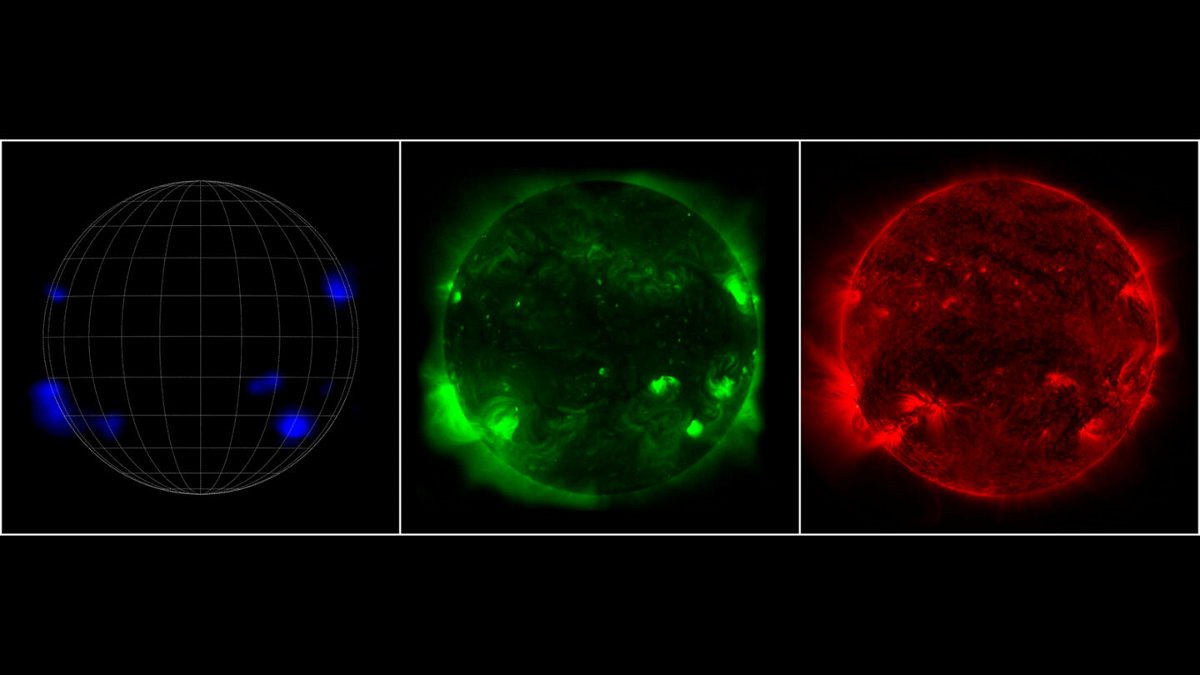New image of the sun could help unravel solar mysteries

While NuSTAR sees high-energy X-rays from the sun in blue (left)
By Ashley Strickland, CNN
A trio of telescopes captured a new view of the sun that reveals the star’s invisible light.
Humans can see optical or visible light, but many wavelengths of light remain hidden from our view.
The NASA NuSTAR mission, or Nuclear Spectroscopic Telescope Array, was able to observe the X-rays released by the hottest spots in the star’s atmosphere. While the telescope can’t view the entirety of the sun from its orbit around the Earth, it took 25 images of high-energy X-rays in the sun’s atmosphere in June.
The telescope, launched in June 2012, was designed to observe massive black holes and collapsed stars outside of the solar system, but it also has a unique perspective of the sun.
In a composite photo above, those X-ray spots, depicted in blue, were combined with data from the Japanese Aerospace Exploration Agency’s Hinode mission, shown in green, and the Atmospheric Imaging Assembly on NASA’s Solar Dynamics Observatory, in red.
Hinode’s X-ray Telescope is designed to detect low-energy X-rays, while the Solar Dynamics Observatory picks up on extreme ultraviolet light.
One of the greatest mysteries about the sun is why its outer atmosphere, or corona, is at least 100 times hotter than its actual surface. Astronomers think the corona’s heat, which reaches a staggering 1 million degrees Celsius (1,800,032 degrees Fahrenheit), could be due to nanoflares — small eruptions in the sun’s atmosphere.
Solar flare activity is heating up
The sun’s activity is increasing as it reaches solar maximum.
Every 11 years, the sun completes a solar cycle of calm and stormy activity and begins a new one. The current solar cycle, Solar Cycle 25, officially began in December 2019, and the next solar maximum, when the sun is experiencing peak activity, is predicted to occur in July 2025.
It’s important to understand the solar cycle because space weather caused by the sun — eruptions such as solar flares and coronal mass ejection events — can affect the power grid, satellites, GPS, airlines, rockets and astronauts in space.
The sun has been releasing more flares, or large outbursts of heat, light and particles that have been captured by solar missions over the past year. Nanoflares are much smaller in scale but occur more frequently than larger flares.
However, both types of events create material that is hotter than the corona’s average temperature.
Nanoflares are too faint to stand apart from the sun’s brightness when they take place, but NuSTAR can detect the energetic material created by nanoflares occurring close together. The telescope’s data can help scientists monitor how frequently nanoflares happen.
The-CNN-Wire
™ & © 2023 Cable News Network, Inc., a Warner Bros. Discovery Company. All rights reserved.